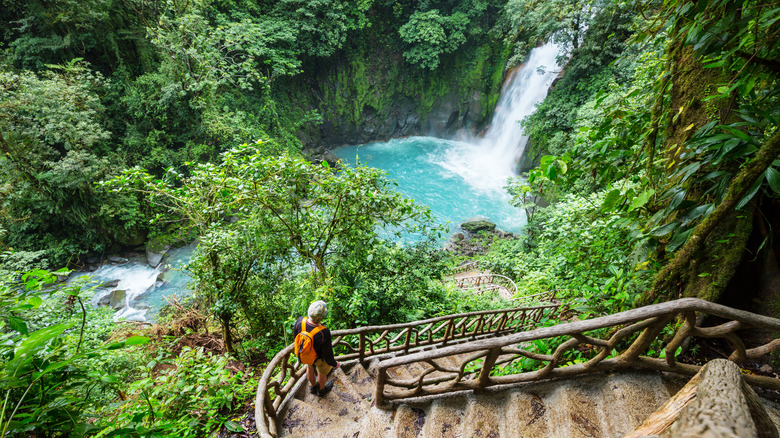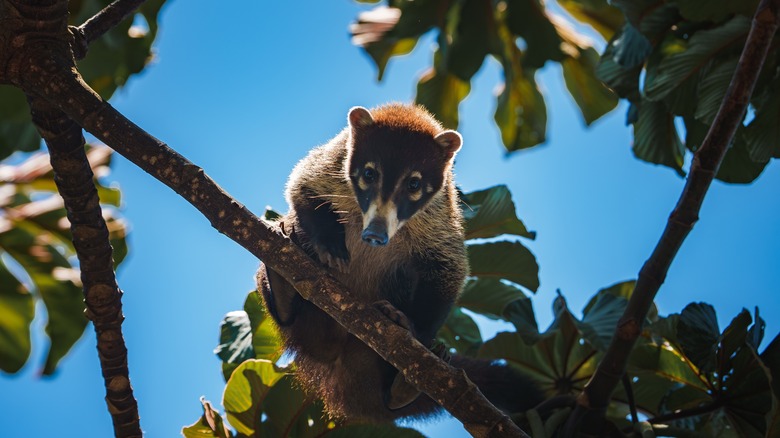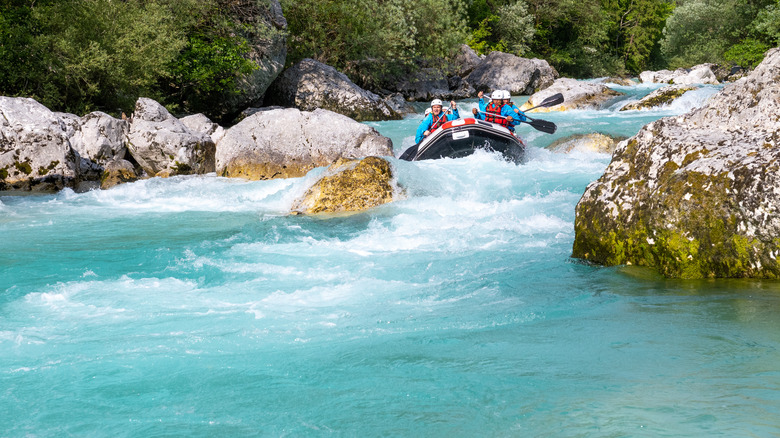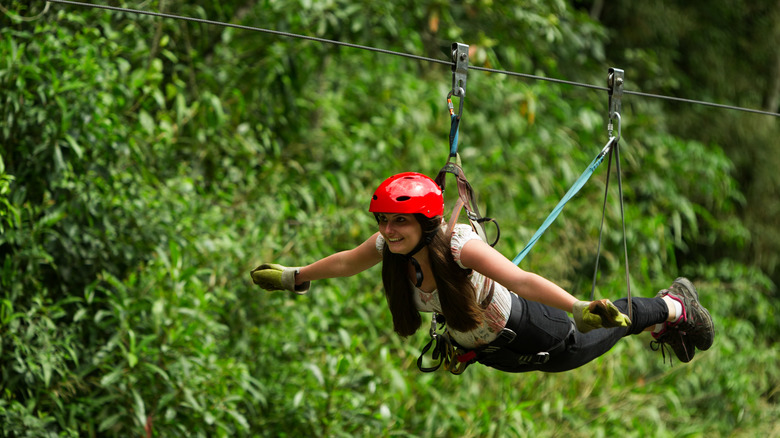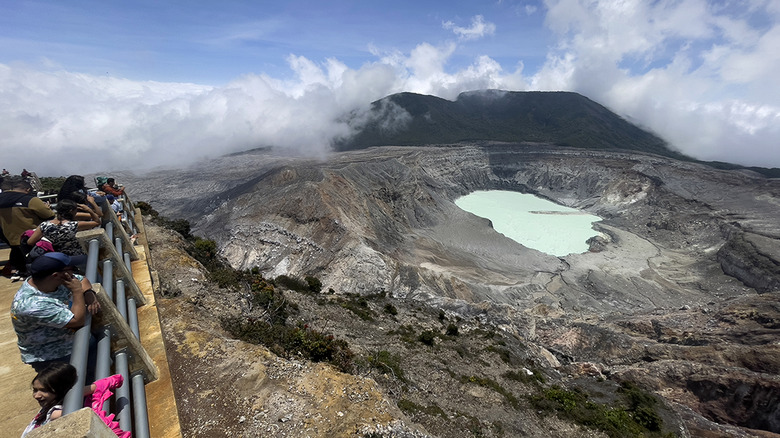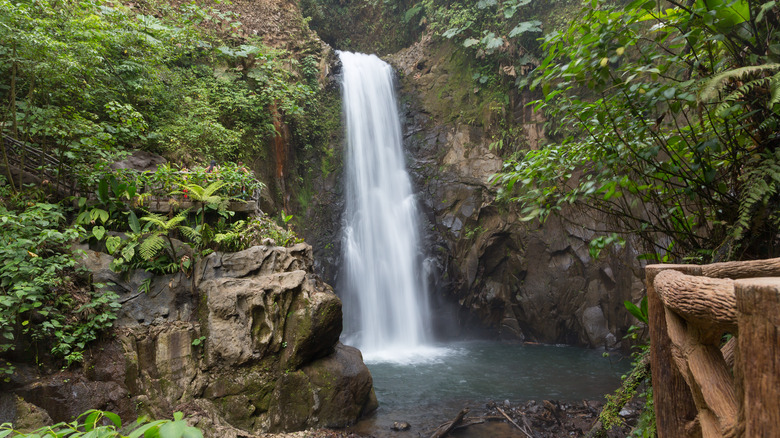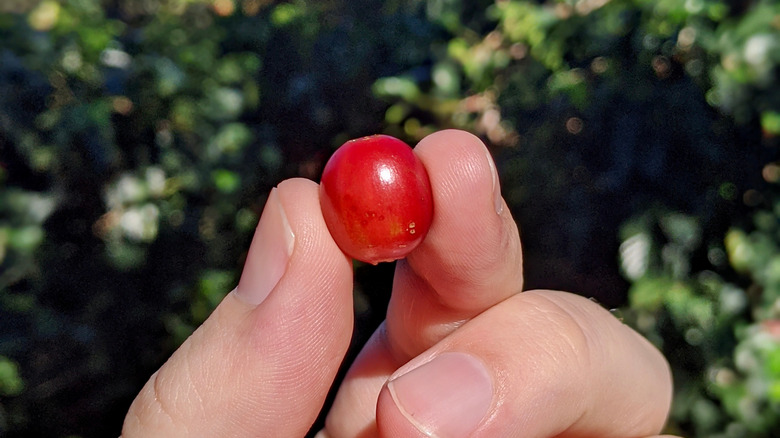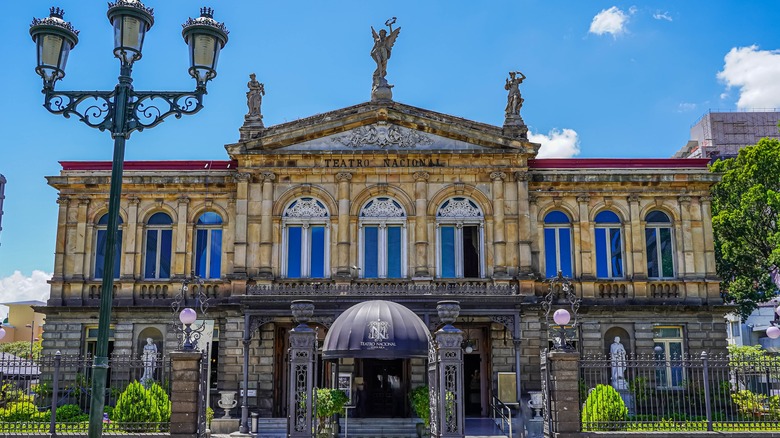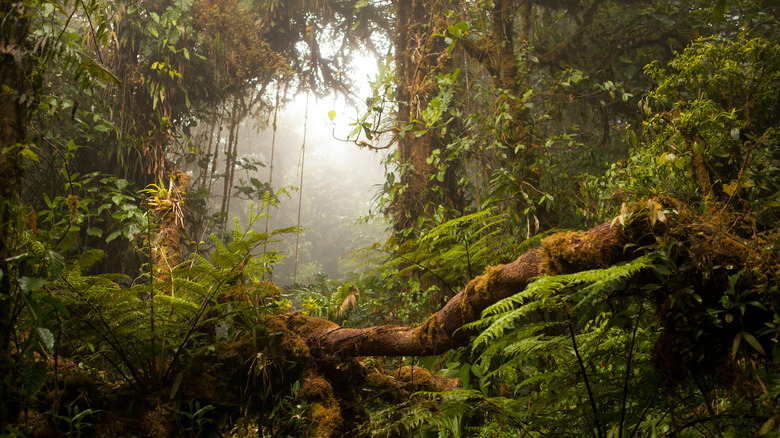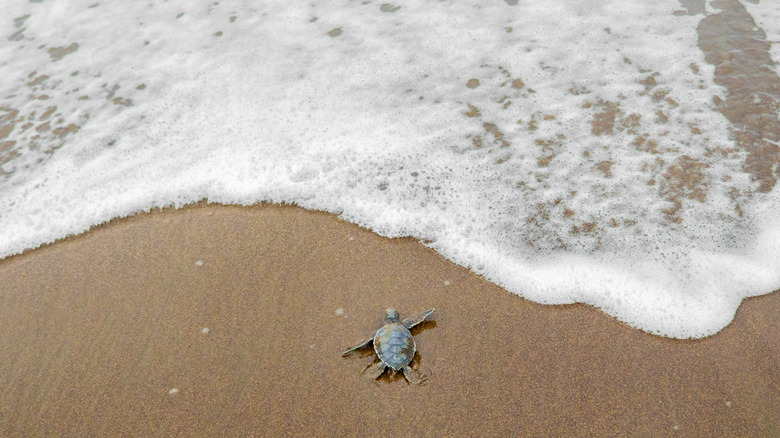Best Things To Do In Costa Rica
Costa Rica is one of the most incredible places in the world. From the peaks of volcanic mountains to the shimmering ocean, a visit to Costa Rica is never the same twice. Even if you have never planned on visiting or it wasn't high on your priority list, you should consider this affordable Central American country for your next adventurous journey. Especially if you are an outdoorsy person, Costa Rica will be heaven for you.
Known for its "pura vida," or pure life greeting that stands for just about everything, to its inimitable national parks, Costa Rica is one destination not to be missed. This country is one of the most biodiverse places on earth. With nearly half a million animal species living there, Costa Rica makes up nearly 5% of the global wildlife population. It's incredible how much one little country can mean to the whole world. You won't get to see everything, though you'd be hard-pressed not to see a lot of CR's varied wildlife. Looking for great things to do in Costa Rica? We have you covered.
Visit Manuel Antonio National Park
One of Costa Rica's several national parks, Manuel Antonio National Park, is easily the most diverse. On top of housing over 200 species of birds and 100 species of mammals, this stunning park is also home to several beaches, which are considered a few of the most beautiful in the country. You can spot all kinds of critters here, from slumbering sloths way up in the tree canopies to delicate little spiders traipsing around near the forest floor.
What you absolutely should do is book a tour with a professional guide beforehand. There are a ton of folks who will try and get you to hire them as you enter the park, but you want to do your research beforehand and get a reputable guide. Ensure your guide will have a spotting scope (like a telescope) with them so that you can see even the teeniest creature from far away. They can even take photos with your phone and the scope to capture what you could barely see with the naked eye.
Go whitewater rafting
Believe it or not, Costa Rica has primo rivers for whitewater rafting. Although it's easy to slot Costa Rica squarely in the surfers and ocean sports vacation category, it's also rife with winding rivers. Even if you've never gone whitewater rafting before, Class II and III (easy to moderate) rapids are readily available. Savegre is a particular favorite for beginners both because it is classified as a Class II and III river and also because it's close to both the resort town of Jacó and Manuel Antonio National Park.
Don't let your newbie rafting status intimidate you; an established guide or tour company will help make you feel safe. In a life jacket and a helmet, you will be well-equipped to handle whatever the water throws at you. Just remember to pay attention to directions from your guide about when to bail into the raft for safety, and you, too, can fall in love with whitewater rafting.
Do a Superman zipline over the rainforest
Sounds intense. Ziplining Superman-style (horizontal) over a rainforest canopy sounds absolutely terrifying if you're afraid of heights. Yet, if you're able to muster the courage, it could very well be one of the most exhilarating things you've ever done -– leading to a burst of joyful tears at the end when you finally catch your breath. Keep in mind that there is a weight limit for this zipline. Participants must weigh less than 280 pounds to participate.
If you can push past the initial fear and shock of careening over a dizzying span of rainforest, you will enjoy truly unparalleled views. These ziplines provide a bird's eye view of the Costa Rican rainforest from the security of a taut line. If you want the moment to last more than mere seconds, bring or rent a GoPro with a helmet attachment. That way, if the sights whiz by too quickly for you to take them in, your camera can capture them in real time for preservation.
Relax in a natural hot spring
Nestled around the base of the active Arenal Volcano in La Fortuna, hot springs are abundant. These natural thermal baths are fed by the underground activity of the volcano and are perfect for unwinding at the end of a long day or just hanging out. They're also not stinky like a lot of natural springs that are sulfuric, so that's a win-win.
There are free springs, which are more like gentle, thermal rivers. Both El Choyin and El Salto are free to visit. They can, however, be difficult to find on your own without a guide. Although you can probably figure it out if there are a lot of locals around, you should ask for directions.
For a more spa-like experience, stop by Baldi Hot Springs. Not only are these pools set up for the ultimate relaxation, but they also comprise the largest hot springs in the world. Day passes are available if you don't want to stay at the on-site hotel.
See one of the country's volcanoes
Arenal Volcano, mentioned above, is Costa Rica's most well-known and active volcano, though it is far from the only one. There are dozens of dormant or extinct volcanoes, as well as five other active ones. Arenal has been in a resting phase since 2010. It still has its cone intact too, so if it decides to erupt again, it will be a traditional-looking eruption.
Meanwhile, several of Costa Rica's other active volcanoes are known as caldera volcanoes. They are cratered inward, often filled with water and a consistent steam. It's wild to see these caldera volcanoes because they just look like foggy pools of dense water. However, that water is hot enough that it would not be a pleasant soak like a hot spring. Even so, these cratered volcanoes are quite a sight to see.
Keep in mind that places like Poás Volcano are aware of the toxic fumes created by the caldera, so you may only have limited time there once you arrive. That said, take your time walking back down from the viewing area at Poás, as you may be dizzy from the fumes.
Check out the waterfall gardens
As if Costa Rica didn't have enough natural wonders to marvel at, La Paz Waterfall Gardens houses several more –- stunning waterfalls to gaze upon. Besides being a way to see the waterfalls, La Paz also has the largest animal sanctuary in the country.
Beyond the sanctuary of Costa Rican animals, there is also a butterfly garden and restaurant for lunch. La Paz also has a hotel called The Peace Lodge which you will see when you arrive. And no, you sadly cannot swim in the waterfalls. Even so, they are beautiful to see and photograph.
These gardens are stunning, though there are a few logistical things to be aware of. In order to access the gardens, you need to be able to descend and ascend over 600 stairs. That means going down those 600 and then climbing them as you go. This is no small feat, even for in-shape visitors. Give yourself time to do this, as you can easily become sick otherwise and lose out on the enjoyable experience.
Eat lunch at a soda
No, not like grabbing a drink from a convenience store. A "soda" in Costa Rica is a local restaurant that usually serves traditional Costa Rican cuisine like the simple, yet incredible, casado. Casado means "marriage" in Spanish and is also the perfect word for a filling, comfort meal. Made up of a protein (like chicken or fish), salad, rice, beans, plantain, or cassava, this dish will keep you full for hours.
These soda stops won't be anything fancy. You'll see them on the side of the road as you drive through the country. Yet what you discover at these oft-hole-in-the-wall locations is some of the best traditional Costa Rican food around. You'll also save a ton of money by finding these locations with their reasonable prices. The trick is to see which sodas are full of Ticos — Costa Ricans — which is often an indicator that the food is good. If the menus and signs are all in English, you probably found a hipster or tourist-oriented eatery. Go find a soda with all-Spanish or bilingual menus and just order casado –- your life and your wallet will thank you.
Learn about Costa Rican coffee
While it isn't the largest coffee plantation in Costa Rica, the Doka Estate is one of the more popular spots to visit. This family-owned coffee plantation will teach you all about the process of farming coffee, from plucking a coffee berry to drying it under the hot sun. Even if you aren't a huge coffee drinker, you'll walk away with a much deeper appreciation of how much it takes just to make one cup of coffee.
You can learn all about the chorreador – or coffee sock as it's colloquially known — and even purchase your own if you wish. Not unlike a pour-over, the chorreador uses a fabric shaped almost like a sock as a sieve for the coffee and hot water.
The Vargas family has been producing coffee for over seven decades, and their Doka Coffee Estate is probably the most popular coffee tour in all of Costa Rica. Whether you get to try the heavenly chocolate frappe or not, it makes sense that Doka remains a solid piece of the country's tourism industry.
Explore San José
With all of the beaches, parks, and natural wonders, it can be easy to forget that San José is right there for exploring. The capital city of Costa Rica, San José has lots of museums, history, and other things to enjoy. It's easy to say that a place has something for everyone, but that's actually true in the case of San José. History buffs will love places like the Pre-Columbian Gold Museum or the National Museum of Costa Rica to learn more about the country.
Meanwhile, culture vultures will clamor for a show at the National Theater of Costa Rica, and the outdoorsy travelers will be at Spirogyra Butterfly Garden waiting for museum time to be over. You don't need a lot of time in this capital city to appreciate it. Even a stopover on the way into or out of Costa Rica may be the right amount of time for you. In either case, San José also makes for a terrific home base while you explore more of the country.
Go sloth spotting
Sloths are an integral part of Costa Rica. You see their likeness everywhere, even if you don't actually see them everywhere. One way you can more easily spot these incredible creatures is by paying a visit to the Sloth Sanctuary. These perezosos, sloths, are protected by Costa Rica too. So while it's tempting to want to touch those cute little guys if one just so happens to be nearby, it's actually illegal in Costa Rica. It's better to stick to the cute sloth backpacks or stuffed animals instead.
These tree-dwellers move so slowly that moss actually grows on them, which makes them harder to see. That's why, just like when visiting Manuel Antonio, you may want to have a guide along that has a scope. Since you likely aren't used to sloth spotting yourself, it'll be handy to have an expert spotter along to ensure you don't miss any sloth action. Though to be fair, that action is usually them sleeping.
See the cloud forests
Pay a visit to the Monteverde Cloud Forest Biological Preserve, which is home to the most diverse orchids on Earth and one of the only cloud forests as well. What makes the cloud forest unique is that the clouds hang so low that the forest appears to be forever surrounded by clouds. Only 1% of all forests on earth are considered cloud forests, so this is a rarity indeed.
Located over 5,000 feet above sea level, the Monteverde Cloud Forest is truly at the height of uniqueness. What makes it even more special though is that, of Costa Rica's wide range of biodiversity, almost 50% of those wildlife species reside in the cloud forest itself. So other than being an incredible and fruitful ecosystem, it is also an extremely important resource to protect.
Sadly, the cloud forest cannot escape climate change even from so high up. The Monteverde Cloud Forest was the first place where a climate-related extinction was recorded. That first extinction was of the golden toad, an endemic resident of the cloud forest until the 1980s.
Spot turtles at Tortuguero Beach
Named for being the nesting place for thousands of sea turtles each year, Tortuguero is the most important hatching site in the western Caribbean for green sea turtles. From February to October, these turtles — along with several other species like loggerheads and hawksbill — will arrive to hatch their eggs. Even if you visit outside of turtle nesting season, Tortuguero National Park is chock full of flora and fauna to enjoy.
If turtles aren't your speed, there are also over 300 species of birds, 60 species of mammals, more than 50 amphibian species, and over 110 species of reptiles here. Especially if you're here specifically to see the turtles nesting during their more active months, you'll want to stay for at least a few days. That way, if they aren't active in the night or evening, you can always try to spot them again the next day. It also rains a lot in this part of Costa Rica, so be prepared to get wet, or protect yourself with an umbrella or poncho.
